So I know it’s not really a blog when you never post anything. Sorry, folks. (You can blame Serge.)
But we’re going to try again to actually do this thing. So, as promised in last quarter’s post, this is going to be about our apartment complex, which was originally officially called Jilong River Public Housing II. We have gathered that it may now have a new, more market-friendly name, but our lack of literacy has prevented us from figuring out what that name is and whether it has been officially assumed. (From the notice we saw, we managed to glean that the new or proposed name contains the word “garden” and does not contain the words “public housing”.) In any case, in conversation, everyone still calls it the public housing complex.
Our friend Peter says it reminds him of the public housing complexes in Singapore. I seem to feel the need to relate everything to New York, so I think of ourselves as living in the equivalent of Stuyvesant Town. (Serge gets credit for coining “Stuypei”.) It’s huge, it’s gentrified, and it has its version of the Stuyvesant Oval:
It’s a lot newer than Stuy Town (it was built about 12 years ago), though you certainly wouldn’t know it to look at it. Like too many buildings in Taiwan, ours is covered with pastel-colored ceramic tiles and grout, which do not age well in a humid climate. So we definitely stand out among all the shiny new condos and hotels in our neighborhood.
There are over 2,000 units in the complex, spread out over 55 buildings. Each building has between 8 and 12 floors, and nearly all of the units are the same size (just under 1000 square feet) and layout (3 bedrooms, 2 bathrooms, a living room, and a galley kitchen). The exceptions are some of the first floor units, some of which seem to be larger and to have private yards.
There are several blocks of commercial activity on the side of the complex that sits on the main road:
And inside the complex, some of the ground-floor apartments are being used for businesses like this barbershop:
There’s even a church:
On rainy days, the giant snails come out:
And on sunny days, people’s bedding comes out:
While everybody calls it public housing, it’s actually privately owned. It’s a bunch of condos that were built with government funds to be sold at below-market prices to buyers who met certain qualifications. It turns out that most publicly financed housing in Taiwan is built for sale rather than rental. I’m not sure what the buyer qualifications were for our particular project, but public housing projects overall have been variously targeted at members of the armed forces, other government employees, other workers in designated trades, families earning below certain income thresholds, disabled individuals, individuals/families fleeing domestic violence, senior citizens, and aborigines.
However, since the time of the original sales, many units in these projects have probably been resold. The projects initially had resale restrictions, but those restrictions were loosened about a decade ago in response to the softening of the country’s real estate market at that time. The new rules allowed owners to sell their units after only one year of residence (versus 5 or more) to any buyer, not just those who met the same qualifications as the original buyers, and there were no restrictions on price. While public housing in Taiwan (which represents less than 5% of all units in the market), does carry a bit of a stigma (unlike Singapore, where 82% of the population lives in public housing), I’m guessing that given the overall rise in Taipei real estate prices over time, many units (many of which are located in high-priced neighborhoods) have been sold or rented out. I have no idea what the numbers are, however. (By the way, if any of you know anything about anything that I’ve been rambling on about, please do comment below.)
We are currently renting our unit from a secondary or possibly tertiary buyer. I’ve met some folks here who are original owners, so they do exist, but I’d guess that our project is one of those that has experienced a lot of turnover in recent years, due to the recent gentrification of Dazhi and the affordability of units here when compared with the surrounding luxury condos.
As for us, well, we really like it here. Sure, in a vacuum, I’d much rather live downtown in an older, livelier neighborhood, or in the old part of Dazhi by the university that I wrote about in my last post, but our complex really works for us. Yes, it’s ugly and institutional, but in a city where most streets are just sidewalk-less alleys where cars and scooters rule the road, here we can let our kids run out the front door and almost all the way to school without holding our hands. There’s lots of car-free space for them to ride their bikes, kick soccer balls, and play Mateo’s version of baseball, and to do all of that with random neighborhood kids who happen to be outside, some of whom roam freely within the complex, no adult guardian in sight, until dinnertime.
And sometimes, despite all the pink tile, it can be kinda pretty here:

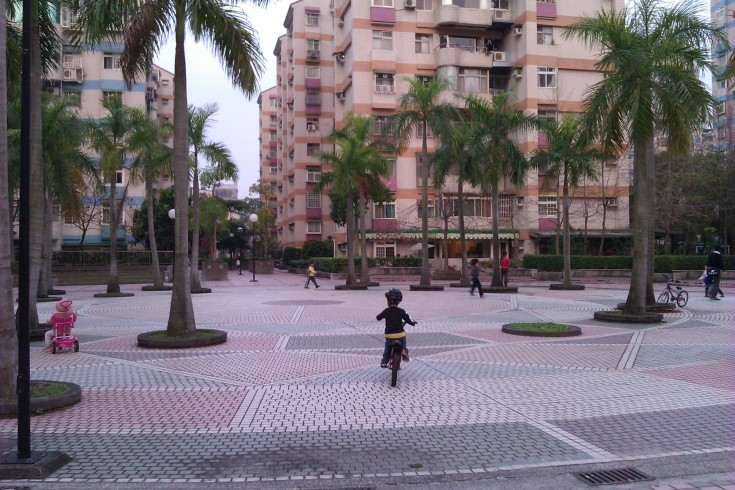
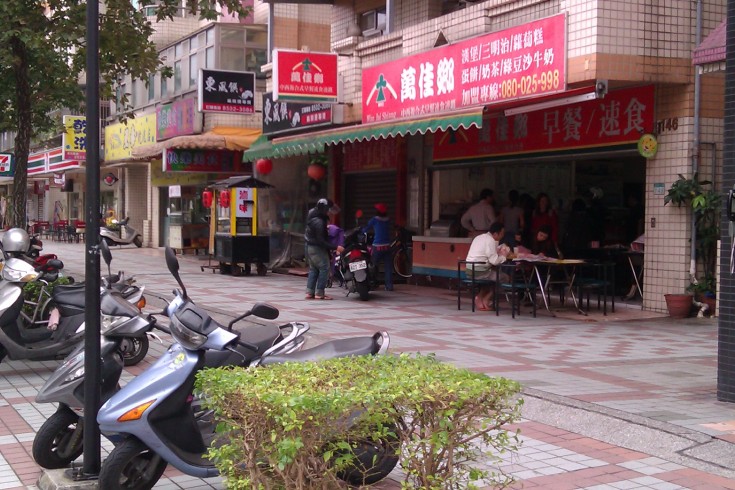
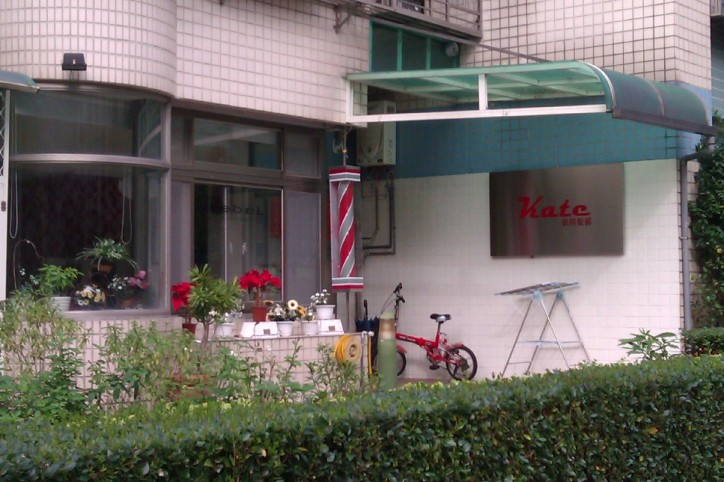
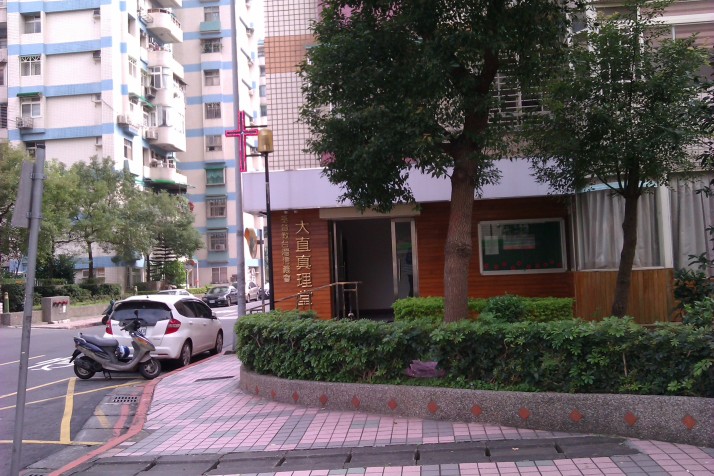
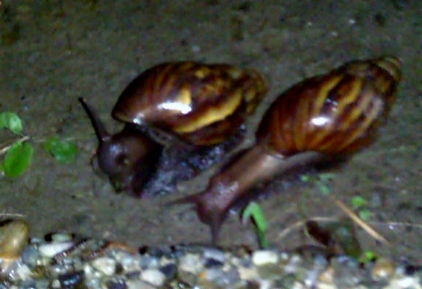
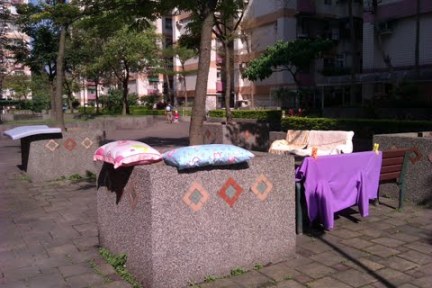
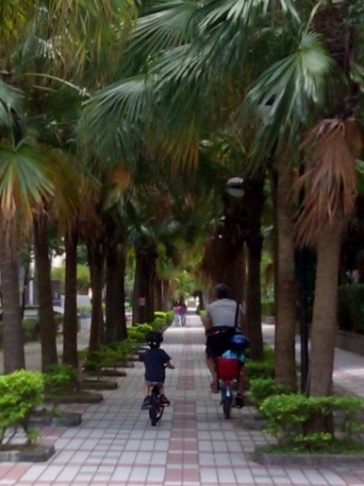
I’m so glad the blog is back up and running. I’m looking forward to more.
Love the giant snails. Have to say I did not see those during our stint!
You probably see them in Seattle all the time, though, right?
I love the snails, but I was hoping to see some geckos too. But maybe you have to be down south for those.
When comparing Stuy Town with HK public housing, I’ve found that there’s a lot to be desired in the public space part that NY could learn from. Unlike private developments that emphasize maximum space utilization, public housing actually considers public spaces such as sitting areas, parks/ trees, etc. I can totally see from your description and photos, why it’s been a great place for the kids.
Love all the photos — incl the gigantic snails.
Miss you here!
Actually, even though the public space in our complex is pretty good, not all of the public housing I’ve seen in Taiwan has decent public space. I’m interested in seeing what public housing in both HK and SIngapore is like, because both have invested a lot more in public housing than Taiwan has.